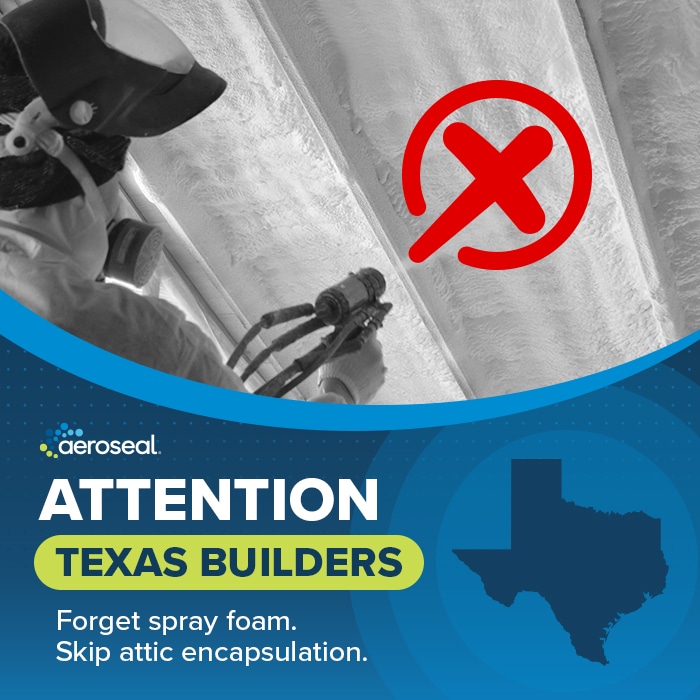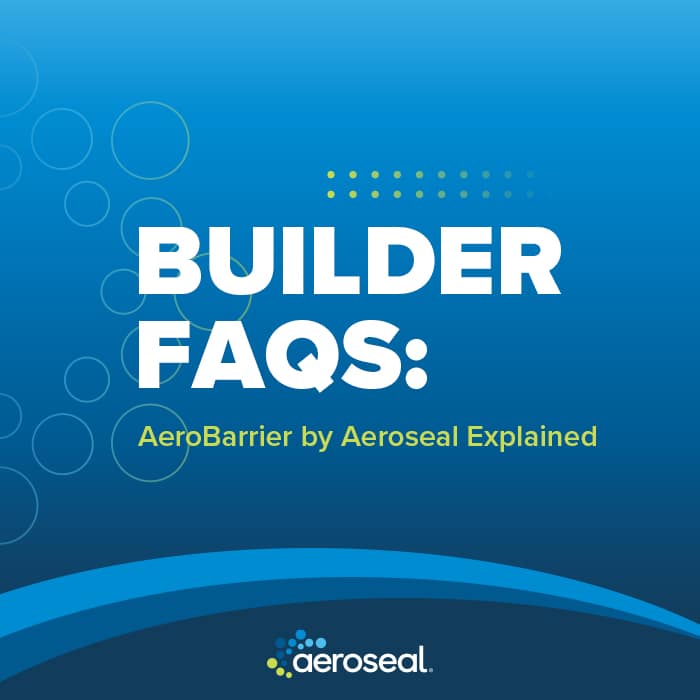What Is Air Sealing? Get Aeroseal’s Complete Guide to Air Sealing

Introduction
No building is safe from air leakage. All buildings—commercial, residential, new, and old —will leak air.
According to the U.S. Department of Energy, 25 to 40% of home energy use can be attributed to leaks in the building envelope and ductwork.
So, how can you have a more energy-efficient home, office, or commercial building if it's leaking air?
Air sealing reduces the amount of air that leaks from your home, office, or building.
Air sealing is one of the best opportunities to save energy — and your heating and cooling costs.
Let’s unpack what air sealing is, its benefits, and why you should download our free Guide to Air Sealing.
What Is Air Sealing?
Air sealing is the process of minimizing or preventing unintended building air flows.
It prevents:
- Outside air from entering the building
- And indoor air escaping to the outside
Air sealing reduces energy loss, lowers energy bills, makes your home or commercial building feel more comfortable, and reduces exposure to allergens and dust.
Now, there are two main ways to properly air seal a home:
1. Air Sealing Duct Leakage
Duct leakage refers to air leaks occurring throughout a building's ductwork or ventilation system.
According to the U.S. Department of Energy, 90% of all residential ductwork has hidden air leaks, with 20 to 30% of air flow lost due to leaks.
Duck leakage is most common at joints and junctions in the ductwork but can be found anywhere in the system.
Reducing air leakage in the ductwork involves locating and sealing leaks in the HVAC system and addressing other inefficiencies within the vent system.
Want to learn more about air sealing?
Get access to our free, complete Guide to Air Sealing here.
2. Air Sealing Building Envelope Leaks
Building envelope air leaks occur in open seams throughout your home, such as:
- Gaps around windows and doors
- Joints in ceilings, floors, and exterior walls
- Structural penetration from piping, wiring, and ducts
To prevent air from escaping, gaps and cracks in these areas (known as the building envelope) need to be sealed.
The Hidden Costs of Air Leakage
Energy Loss
Up to 40% of home energy use can be attributed to leaks in the building envelope and ductwork, resulting in higher heating and cooling costs.
Comfort Issues
Poor air sealing around the edges of building joints and junctures or ductwork leads to drafts, hot and cold spots, and uneven temperature distribution.
Health Risks
Air leaks can introduce dust, allergens, and pollutants inside the house, negatively impacting indoor air quality and your health.
Common Air Sealing Techniques and Their Limitations
Traditional Approaches to Home Air Sealing
- Caulking
- Weather stripping
- Attic and wall insulation
- Mastic sealant
- Duct tape sealant
There are potential problems with many air-sealing techniques and materials:
- Durability: The materials used degrade over time, requiring regular maintenance. In more extreme temperatures, the materials degrade faster.
- Improper installation: Improper installation can result in new cracks and gaps and reduced effectiveness.
- Incompatible material: Certain building and air sealing materials will not interact well with each other, reducing long-term effectiveness.
- Cost of installation: The cost of air sealing methods can be high, especially for methods that require regular upkeep and multiple applications.
- Access: Manual duct sealing methods can be performed in new home construction, but not for many existing buildings. In older homes, the ductwork is difficult to access and often requires demolishing ceilings and walls.
- Uncleanliness: Air sealing materials for ducts can attract dust and debris, negatively impacting indoor air quality over time.
While traditional methods offer some benefits, they often fall short as a long-term solution.
Why Choose Aeroseal for Superior Air Sealing
Aeroseal Duct
Aeroseal Duct blocks all registers and intakes to pressurize HVAC systems.
Our automated system distributes sealant inside the ductwork. The particles of the sealant gather around gaps in the vent and accumulate until the gaps are sealed shut.
We use computerized measurements to determine when the leaks have been properly sealed.
Aeroseal Duct eliminates demolition and construction costs and also only takes a few hours, which reduces your labor costs.
Homeowners and commercial property managers receive an analysis and certification of completion, which shows the before-and-after results of the air sealing process.
Aeroseal Envelope
Aeroseal’s technology uses a pressurized blower to distribute a non-toxic, water-based sealing foam throughout the building envelope.
Aeroseal Envelope ensures precise control, uniform coverage, and an airtight barrier, and can even seal undetectable leaks.
Our non-invasive automated sealing process only takes a few hours and is monitored every 60 seconds.
Aeroseal technicians can measure results immediately and can achieve same-day blower door test certification.
Proven Results
Aeroseal solutions:
- Reduce up to 95% of leaks
- Lower energy costs up to 30%
- Achieve <1% of duct leakage
The Benefits of Air Sealing with Aeroseal
Energy Efficiency
Aeroseal can lower energy costs by up to 30% and reduce 95% of air leaks. This means your HVAC system won't have to work as hard, increasing its lifespan.
Improved Comfort
Proper air sealing can make your house more comfortable. It eliminates drafts and helps maintain consistent indoor temperatures.
Health and Well-Being
Preventing outside to inside air movement reduces exposure to dust, allergens, and pollutants.
Download Aeroseal’s Free Guide to Air Sealing: Take the First Step Toward Making Your Home More Comfortable and Energy Efficient
Download the free Guide to Air Sealing to learn more about identifying air leaks, the benefits of air sealing, and more:
- Negative impacts of air leakage
- Where Aeroseal can be used
- How Aeroseal meets state energy requirements and building code standards
Conclusion
Air sealing your home provides many benefits:
- Improved energy efficiency
- Reduced energy bills
- Comfortable home
- Reduced exposure to allergens
- Improved air quality
But as discussed, not all air sealing methods are equal. Aeroseal is more efficient and effective.
Download our free Guide to Air Sealing for more information. If you're ready to work with the best professional air sealers, contact Aeroseal for a consultation (or to request further information).













